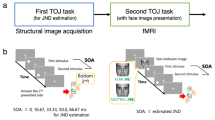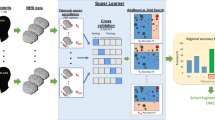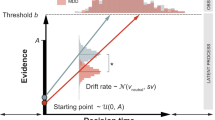Abstract
Children with anxiety disorders (ADs) experience persistent fear and worries that are highly debilitating, conferring risk for lifelong psychopathology. Anticipatory anxiety is a core clinical feature of childhood ADs, often leading to avoidance of uncertain and novel situations. Extensive studies in non-human animals implicate amygdala dysfunction as a critical substrate for early life anxiety. To test specific amygdala-focused hypotheses in preadolescent children with ADs, we used fMRI to characterize amygdala activation during uncertain anticipation and in response to unexpected stimuli. Forty preadolescent (age 8–12 years) children, 20 unmedicated AD patients and 20 matched controls completed an anticipation task during an fMRI scan. In the task, symbolic cues preceded fear or neutral faces, such that ‘certain’ cues always predicted the presentation of fear or neutral faces, whereas ‘uncertain’ cues were equally likely to be followed by fear or neutral faces. Both AD children and controls showed robust amygdala response to faces. In response to the uncertain cues, AD children had increased amygdala activation relative to controls. Moreover, in the AD children, faces preceded by an ‘uncertain’ cue elicited increased amygdala activation, as compared with the same faces following a ‘certain’ cue. Children with ADs experience distress both in anticipation of and during novel and surprising events. Our findings suggest that increased amygdala activation may have an important role in the generation of uncertainty-related anxiety. These findings may guide the development of neuroscientifically informed treatments aimed at relieving the suffering and preventing the lifelong disability associated with pediatric ADs.
Similar content being viewed by others
Log in or create a free account to read this content
Gain free access to this article, as well as selected content from this journal and more on nature.com
or
References
Aggleton JP, Passingham RE (1981). Syndrome produced by lesions of the amygdala in monkeys (Macaca mulatta). J Comp Physiol Psychol 95: 961–977.
Beesdo K, Lau JY, Guyer AE, McClure-Tone EB, Monk CS, Nelson EE et al (2009). Common and distinct amygdala-function perturbations in depressed vs anxious adolescents. Arch Gen Psychiatry 66: 275–285.
Birmaher B, Brent DA, Chiappetta L, Bridge J, Monga S, Baugher M (1999). Psychometric properties of the Screen for Child Anxiety Related Emotional Disorders (SCARED): a replication study. J Am Acad Child Adolesc Psychiatry 38: 1230–1236.
Birmaher B, Ehmann M, Axelson DA, Goldstein BI, Monk K, Kalas C et al (2009). Schedule for affective disorders and schizophrenia for school-age children (K-SADS-PL) for the assessment of preschool children—a preliminary psychometric study. J Psychiatr Res 43: 680–686.
Birn RM, Shackman AJ, Oler JA, Williams LE, McFarlin DR, Rogers GM et al (2014). Evolutionarily conserved prefrontal-amygdalar dysfunction in early-life anxiety. Mol Psychiatry 19: 915–922.
Compton SN, Walkup JT, Albano AM, Piacentini JC, Birmaher B, Sherrill JT et al (2010). Child/Adolescent Anxiety Multimodal Study (CAMS): rationale, design, and methods. Child Adolesc Psychiatry Ment Health 4: 1.
Conners CK, Sitarenios G, Parker JD, Epstein JN (1998). The revised Conners' Parent Rating Scale (CPRS-R): factor structure, reliability, and criterion validity. J Abnorm Child Psychol 26: 257–268.
Connolly SD, Bernstein GA (2007). Practice parameter for the assessment and treatment of children and adolescents with anxiety disorders. J Am Acad Child Adolesc Psychiatry 46: 267–283.
Costello EJ, Egger HL, Angold A (2005). The developmental epidemiology of anxiety disorders: phenomenology, prevalence, and comorbidity. Child Adolesc Psychiatr Clin N Am 14: 631–648 vii.
Cox RW (1996). AFNI: software for analysis and visualization of functional magnetic resonance neuroimages. Comput Biomed Res 29: 162–173.
Davis M, Whalen PJ (2001). The amygdala: vigilance and emotion. Mol Psychiatry 6: 13–34.
Dunsmoor JE, Bandettini PA, Knight DC (2007). Impact of continuous versus intermittent CS-UCS pairing on human brain activation during Pavlovian fear conditioning. Behav Neurosci 121: 635–642.
Ekman P, Friesen W (2006) Pictures of Facial Affect. Consulting Psychologists Press: Palo Alto.
Etkin A, Wager TD (2007). Functional neuroimaging of anxiety: a meta-analysis of emotional processing in PTSD, social anxiety disorder, and specific phobia. Am J Psychiatry 164: 1476–1488.
Fusar-Poli P, Placentino A, Carletti F, Landi P, Allen P, Surguladze S et al (2009). Functional atlas of emotional faces processing: a voxel-based meta-analysis of 105 functional magnetic resonance imaging studies. J Psychiatry Neurosc 34: 418–432.
Gabard-Durnam LJ, Flannery J, Goff B, Gee DG, Humphreys KL, Telzer E et al (2014). The development of human amygdala functional connectivity at rest from 4 to 23years: a cross-sectional study. NeuroImage 95C: 193–207.
Giedd JN (2004). Structural magnetic resonance imaging of the adolescent brain. Annals NY Acad Sci 1021: 77–85.
Grupe DW, Nitschke JB (2013a). Uncertainty and anticipation in anxiety: an integrated neurobiological and psychological perspective. Nat Rev Neurosci 14: 488–501.
Grupe DW, Oathes DJ, Nitschke JB (2013b). Dissecting the anticipation of aversion reveals dissociable neural networks. Cerebral Cortex 23: 1874–1883.
Guyer AE, Choate VR, Detloff A, Benson B, Nelson EE, Perez-Edgar K et al (2012). Striatal functional alteration during incentive anticipation in pediatric anxiety disorders. Am J Psychiatry 169: 205–212.
Guyer AE, Monk CS, McClure-Tone EB, Nelson EE, Roberson-Nay R, Adler AD et al (2008). A developmental examination of amygdala response to facial expressions. J Cogn Neurosci 20: 1565–1582.
Hare TA, Tottenham N, Galvan A, Voss HU, Glover GH, Casey BJ (2008). Biological substrates of emotional reactivity and regulation in adolescence during an emotional go-nogo task. Biol Psychiatry 63: 927–934.
Hattingh CJ, Ipser J, Tromp SA, Syal S, Lochner C, Brooks SJ et al (2012). Functional magnetic resonance imaging during emotion recognition in social anxiety disorder: an activation likelihood meta-analysis. Front Hum Neurosci 6: 347.
Kalin NH, Shelton SE, Davidson RJ (2004). The role of the central nucleus of the amygdala in mediating fear and anxiety in the primate. J Neurosci 24: 5506–5515.
Kendall PC, Compton SN, Walkup JT, Birmaher B, Albano AM, Sherrill J et al (2010). Clinical characteristics of anxiety disordered youth. J Anxiety Disord 24: 360–365.
Kessler RC, Gruber M, Hettema JM, Hwang I, Sampson N, Yonkers KA (2008). Co-morbid major depression and generalized anxiety disorders in the National Comorbidity Survey follow-up. Psychol Med 38: 365–374.
Kovacs M (1985). The Children’s Depression Inventory (CDI). Psychopharmacol Bull 21: 995–998.
Krain AL, Gotimer K, Hefton S, Ernst M, Castellanos FX, Pine DS et al (2008). A functional magnetic resonance imaging investigation of uncertainty in adolescents with anxiety disorders. Biol Psychiatry 63: 563–568.
Krain AL, Hefton S, Pine DS, Ernst M, Castellanos FX, Klein RG et al (2006). An fMRI examination of developmental differences in the neural correlates of uncertainty and decision-making. J Child Psychol Psychiatry 47: 1023–1030.
LeDoux J (2007). The amygdala. Curr Biol 17: R868–R874.
McClure EB, Monk CS, Nelson EE, Parrish JM, Adler A, Blair RJ et al (2007). Abnormal attention modulation of fear circuit function in pediatric generalized anxiety disorder. Arch Gen Psychiatry 64: 97–106.
Morris NM, Udry JR (1980). Validation of a self-administered instrument to assess stage of adolescent development. J Youth Adolesc 9: 271–280.
Nitschke JB, Sarinopoulos I, Oathes DJ, Johnstone T, Whalen PJ, Davidson RJ et al (2009). Anticipatory activation in the amygdala and anterior cingulate in generalized anxiety disorder and prediction of treatment response. Am J Psychiatry 166: 302–310.
Oler JA, Fox AS, Shelton SE, Rogers J, Dyer TD, Davidson RJ et al (2010). Amygdalar and hippocampal substrates of anxious temperament differ in their heritability. Nature 466: 864–868.
Pagliaccio D, Luby JL, Gaffrey MS, Belden AC, Botteron KN, Harms MP et al (2013). Functional brain activation to emotional and nonemotional faces in healthy children: evidence for developmentally undifferentiated amygdala function during the school-age period. Cogn Affect Behav Neurosci 13: 771–789.
Phan KL, Coccaro EF, Angstadt M, Kreger KJ, Mayberg HS, Liberzon I et al (2013). Corticolimbic brain reactivity to social signals of threat before and after sertraline treatment in generalized social phobia. Biol Psychiatry 73: 329–336.
Phillips ML, Young AW, Scott SK, Calder AJ, Andrew C, Giampietro V et al (1998). Neural responses to facial and vocal expressions of fear and disgust. Proc Biol Sci 265: 1809–1817.
Pine DS, Cohen P, Gurley D, Brook J, Ma Y (1998). The risk for early-adulthood anxiety and depressive disorders in adolescents with anxiety and depressive disorders. Arch Gen Psychiatry 55: 56–64.
Qin S, Young CB, Supekar K, Uddin LQ, Menon V (2012). Immature integration and segregation of emotion-related brain circuitry in young children. Proc Natl Acad Sci USA 109: 7941–7946.
Rosen JB, Donley MP (2006). Animal studies of amygdala function in fear and uncertainty: relevance to human research. Biol Psychol 73: 49–60.
Sarinopoulos I, Grupe DW, Mackiewicz KL, Herrington JD, Lor M, Steege EE et al (2010). Uncertainty during anticipation modulates neural responses to aversion in human insula and amygdala. Cerebral Cortex 20: 929–940.
Stein MB (2009). Neurobiology of generalized anxiety disorder. J Clin Psychiatry 70 Suppl 2: 15–19.
Telzer EH, Flannery J, Shapiro M, Humphreys KL, Goff B, Gabard-Durman L et al (2013). Early experience shapes amygdala sensitivity to race: an international adoption design. J Neurosci 33: 13484–13488.
Thomas KM, Drevets WC, Whalen PJ, Eccard CH, Dahl RE, Ryan ND et al (2001). Amygdala response to facial expressions in children and adults. Biol Psychiatry 49: 309–316.
Tottenham N, Hertzig ME, Gillespie-Lynch K, Gilhooly T, Millner AJ, Casey BJ (2014). Elevated amygdala response to faces and gaze aversion in autism spectrum disorder. Soc Cogn Affect Neurosci 9: 106–117.
Tottenham N, Tanaka JW, Leon AC, McCarry T, Nurse M, Hare TA et al (2009). The NimStim set of facial expressions: judgments from untrained research participants. Psychiatry Res 168: 242–249.
Walkup JT, Labellarte MJ, Riddle MA, Pine DS, Greenhill L, Klein R et al, for the Research Unit on Pediatric Psychopharmacology Anxiety Study Group (2001). Fluvoxamine for the treatment of anxiety disorders in children and adolescents. N Engl J Med 344: 1279–1285.
Whalen PJ (2007). The uncertainty of it all. Trends Cogn Sci 11: 499–500.
Whalen PJ, Shin LM, McInerney SC, Fischer H, Wright CI, Rauch SL (2001). A functional MRI study of human amygdala responses to facial expressions of fear versus anger. Emotion 1: 70–83.
Yassa MA, Hazlett RL, Stark CE, Hoehn-Saric R (2012). Functional MRI of the amygdala and bed nucleus of the stria terminalis during conditions of uncertainty in generalized anxiety disorder. J Psychiatr Res 46: 1045–1052.
Acknowledgements
We acknowledge the assistance of Anna White and Travis Doran, and the staffs of the HealthEmotions Research Institute (HERI) and Lane Neuroimaging Laboratory. This work was supported by the National Institutes of Health grant R21 MH092581 (NHK and JAO).
Author information
Authors and Affiliations
Corresponding author
Additional information
Supplementary Information accompanies the paper on the Neuropsychopharmacology website
Supplementary information
Rights and permissions
About this article
Cite this article
Williams, L., Oler, J., Fox, A. et al. Fear of the Unknown: Uncertain Anticipation Reveals Amygdala Alterations in Childhood Anxiety Disorders. Neuropsychopharmacol 40, 1428–1435 (2015). https://doi.org/10.1038/npp.2014.328
Received:
Revised:
Accepted:
Published:
Issue date:
DOI: https://doi.org/10.1038/npp.2014.328
This article is cited by
-
A dynamic relation between whole-brain white matter microstructural integrity and anxiety symptoms in preadolescent females with pathological anxiety
Translational Psychiatry (2022)
-
Acute neurofunctional effects of escitalopram during emotional processing in pediatric anxiety: a double-blind, placebo-controlled trial
Neuropsychopharmacology (2022)
-
Young patients’ self-reported fear compared to professionals’ assessments during invasive and non-invasive dental visits: a prospective, longitudinal study
European Archives of Paediatric Dentistry (2022)
-
Psychophysiological mechanisms underlying the failure to speak: a comparison between children with selective mutism and social anxiety disorder on autonomic arousal
Child and Adolescent Psychiatry and Mental Health (2021)
-
The electrophysiology correlation of the cognitive bias in anxiety under uncertainty
Scientific Reports (2020)



